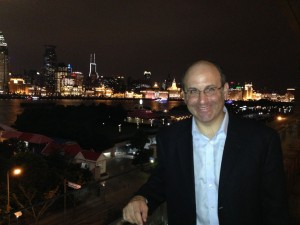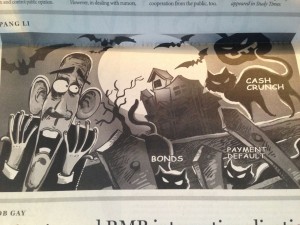As Americans struggled to understand how a small group of people featuring small-time cranks and singin’ funeral directors could nearly destroy the full faith and credit of the US, I went to Shanghai this week to staff a visiting committee for our partner graduate program. These visits always bring up their own fascinating inter-cultural communications issues, though not across quite the gap that lies between me and Ted Effin Yoho (R-FL) [I urge you to click through to this piece by Charlie Pierce, which really sums up why Yoho is the apotheosis of the last few decades of political extremism].
The visiting committee consisted of three MIT professors and two people from US companies who work in their Chinese manufacturing facilities and support our sister program. What made the interaction even more interesting between this group and the Chinese deans, faculty, and students was that the MIT faculty were born in China and Greece, and one of the industry people was Iranian-American. In discussion, I was interested to hear some of the committee members talk about their own bicultural experiences of communications and authority, and having one personality in their native language and another in English.
What did the Chinese make of our political debacle? Here’s what the China Daily political cartoonist came up with…Halloween theme, frightened Obama scared of three spooky cats labeled Bonds, Payment Default, and Cash Crunch. I would have loved to see the artist’s rendering of Michelle Bachmann, but sometimes a Cash Crunch cat is just a cat. I guess there was a lot of official propaganda talk this week about America’s self-immolation allowing the “de-Americanization” of the global community…and a long-awaited re-Sinification! What’s weird to me is that this cartoon misses the most basic political reality of the situation, which was that it was Obama’s political enemies who made it all happen. If anyone who knows feels like telling me, I would love to hear if the cartoon’s version of things (Obama vs. scary things that came up out of nowhere) reflects a Chinese understanding of The Leader in absolute terms? Elsewhere in the paper, I saw pitch-perfect renderings of China Daily tropes: a story about the “Dalai Lama clique” and its nefarious work to orphan Tibetan children in the 60s, and one about rare brown-and-white giant pandas that raved about how cute they are (because honestly, who doesn’t love a panda? Or, by extension, China in general?).
I also went back to one of my favorite areas in Shanghai, Tian Zi Fang, a traditional alleyway residential area partially transformed into a shopping and gallery district. There are still people living there, their streets set off from commerce with “NO PHOTO” and “KEEP OUT” signs, and each visit I’ve heard the sound of kids practicing their instruments floating down from apartment windows. Perhaps because of those signs, I don’t feel like I’m getting into people’s living space when in Tian Zi Fang.

Dude with mohawk and camo floppy boots touching up the paint on a mock-carousel horse outside Burberry on Huaihai Rd, Shanghai
But later I was walking on Huaihai Road, where Gucci and Cartier have stores as big as Costcos, and found just a block off the street an even less improved stretch of alleyways, with people washing food in outdoor sinks and sitting on buckets under laundry lines. There was no way to walk down there and not be in people’s space. In its proximity to posher areas, it kind of reminded me of walking along a narrow promenade by the Douro River in the heart of Porto and having to squeeze by the laundry rack sticking out of a window.
Finally I got over to the Shanghai Museum. I’m the kind of uncultured lummox who generally will not cross the street to see fine ceramics, but the pottery at this museum really had me saying OMG in my head as I turned from one vitrine to the next. What’s more, there was a traveling exhibit of Impressionists and others from the Clark Museum in Williamstown (boo!), featuring none other than Gerome’s “The Snake Charmer,” which as everyone knows was on the cover of Edward Said’s Orientalism. I remembered enough of the book, which found in “Orientalist” art of the 19th C. an aesthetic reification of Middle Eastern peoples subordinated to the West, to realize that seeing its cover art in a giant Chinese boomtown whose leaders had just claimed their right to “de-Westernize” the world made for a very rich textual moment.




